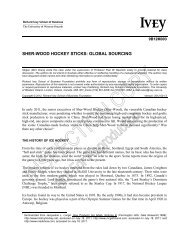foundation of canada asia pacific - Content Tagged with
foundation of canada asia pacific - Content Tagged with
foundation of canada asia pacific - Content Tagged with
Create successful ePaper yourself
Turn your PDF publications into a flip-book with our unique Google optimized e-Paper software.
ECONOMIC RELATIONS<br />
3<br />
looking for<br />
a new model<br />
35<br />
For more than a decade, the Government <strong>of</strong> Canada and, to a lesser extent, the provincial<br />
governments, have adopted policies and programs intended to boost Canada’s business<br />
relationship <strong>with</strong> Asia. Through membership in the Asia Pacific Economic Cooperation<br />
(APEC) Forum, through the much-publicized Team Canada trade missions, and through<br />
support for the Asia Pacific Foundation itself, Ottawa and at least some <strong>of</strong> the provinces<br />
have demonstrated their belief that greater economic ties <strong>with</strong> Asia are beneficial to the<br />
development <strong>of</strong> the Canadian economy. They showed this most consistently in their<br />
support for expanded trade. These efforts seemed to be paying <strong>of</strong>f in terms <strong>of</strong> exports,<br />
at least until the Asian economic crisis hit. After six years <strong>of</strong> stagnation, exports grew strongly<br />
in the mid-1990s, even though development <strong>of</strong> markets was hindered by an overly heavy<br />
reliance on commodities and lightly processed raw materials.<br />
The other element <strong>of</strong> the economic relationship <strong>with</strong> Asia — investment — followed an<br />
opposite trend. After growing strongly in the early 1990s, at a time when the Canadian<br />
dollar was strong, Canadian direct investment in Asia (DIA) has been relatively flat since<br />
1994, perhaps reflecting the low-key promotion <strong>of</strong> outward investment by Canadian<br />
governments, a depreciated Canadian currency, plus the strong rival attraction for Canadian<br />
business <strong>of</strong> the vibrant US economy. If it were to continue, this slowdown in DIA would<br />
have a long-term dampening effect on our trade <strong>with</strong> Asia. Changes that globalization<br />
brought to the relationship between investment and trade have made foreign direct<br />
investment (FDI) a major stimulus to trade, rather than a substitute. Canadian governments<br />
are just beginning to recognize this by looking to a new model for developing commercial<br />
ties <strong>with</strong> Asia — one that promotes outward direct investment <strong>with</strong> equal vigour to<br />
that given to trade.<br />
Globalization has changed the way countries trade and the reasons why companies<br />
invest <strong>of</strong>fshore. Traditionally, economies traded resources which they had in abundance<br />
or products they could produce more competitively than their rivals. Companies made<br />
foreign investments to secure their sources <strong>of</strong> raw materials or to manufacture their<br />
products inside protected markets on the same terms as domestic firms, <strong>with</strong>out having<br />
to worry about tariffs and other import barriers. In this environment, foreign investment<br />
was a substitute for trade. Today that scenario no longer holds true. Foreign



